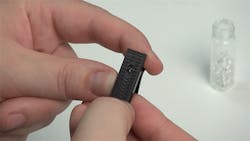3D Printing Turns a Smartphone into a Microscope
Scientists working in the field often can’t carry heavy and costly equipment like microscopes, but these are often needed to quickly identify biochemical agents. To solve this problem, a scientist at the Pacific Northwest National laboratory (PNNL) designed an inexpensive 3D-printed clip that turns a smartphone’s camera into a high-powered, high-quality microscope that can be used in the field to identify biological samples such as anthrax and other chemical and biological threats. This simple device could help U.S. Homeland Security in rapidly detecting threats, and help doctors and veterinarians in developing countries.
The clip has a cavity that holds a glass bead in alignment with the phone’s camera. The size of the bead lens determines the magnification.To find parasites in blood samples or protozoa in drinking water, around 350x is needed. Even stronger magnification is needed to see tiny pathogens (~1,000x). These magnifications are possible with this device. PNNL have used beads for 100x, 350x, and 1000x. The small size, high magnification, and low cost are what makes this device practical.
PNNL offers free clip 3D-printable designs for several smartphone models on its website. The material and glass bead for a phone-microscope cost less than a dollar, and glass beads cost $16 to $36 per pound. This has made PNNL’s design desirable for educators with limited resources.
For instructions on building a cellphone microscope, visit http://tinyurl.com/mm2eohl.
PNNL also provides links to vendors offering 3D printing services and information for ordering the glass beads.
